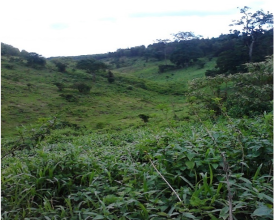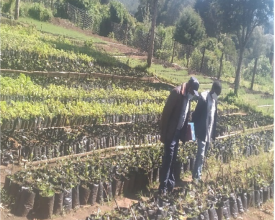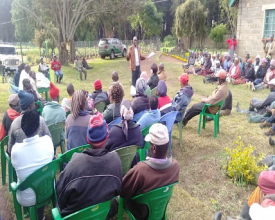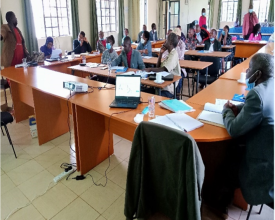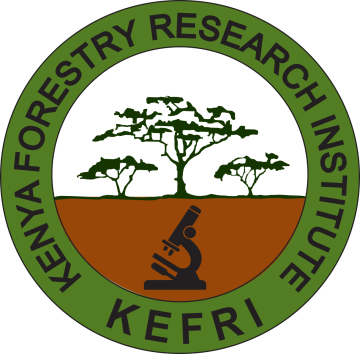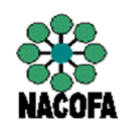
Community-led policy advocacy on Natural Resources Management in Kenya
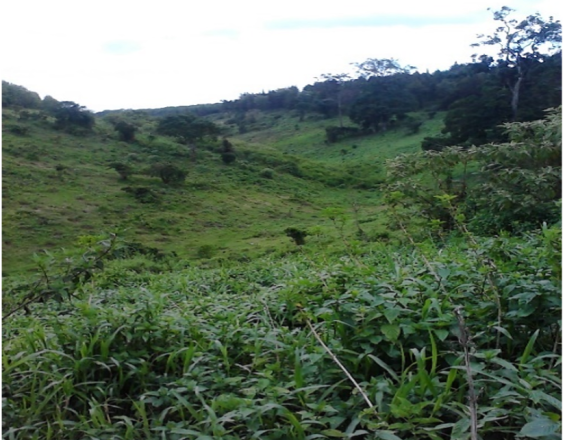
NACOFA gathers community feedback on Forest and Landscape Restoration (FLR) and Natural Resource Management (NRM) challenges, such as degradation. It analyzes existing laws and policies to identify gaps and inconsistencies that hinder effective solutions. To empower its CFA members, NACOFA builds their capacity in policy advocacy, teaching them to influence policymakers, secure inclusion in consultative forums, and impact policy planning and implementation. Collaboration with government bodies like the Ministry of Environment, Kenya Forest Service, and County NRM departments addresses these gaps through policy reviews, amendments, and new regulations. NACOFA also formed coalitions with stakeholders to tackle policy issues. When governments are slow or resistant to change, NACOFA engages in horizontal advocacy by working within government oversight structures, such as Technical Working Groups and Forest Conservation Committees, to influence policy from within.
Contexte
Challenges addressed
The world is grappling with the severe impacts of three planetary emergencies: biodiversity loss, climate change, and pollution, leading to widespread landscape and ecosystem degradation. Forests, which cover 31% of global land, continue to face deforestation and degradation at alarming rates, despite a slowdown in net forest loss since 1990. Kenya mirrors these challenges, with 38.8 million hectares of degraded landscapes due to population pressure, climate change, deforestation, and poor land use. These factors threaten livelihoods by reducing the availability of ecosystem goods and services. Despite government commitments and policies aimed at restoring landscapes and forests, implementation remains a significant challenge, hindered by policy gaps, lack of benefit-sharing systems, and inadequate community awareness.
Emplacement
Traiter
Summary of the process
The building blocks interact synergistically to drive successful policy outcomes. Building Block 1 identifies local environmental challenges and gaps in existing laws, setting the stage for targeted intervention. Building Block 2 then maps stakeholders and reviews current policies, ensuring that all relevant interests are considered and gaps are identified. This informed mapping guides Building Block 3, where policy formulation and development are undertaken, integrating community needs with broader political and global commitments. Building Block 4 focuses on capacity building and awareness creation, empowering communities and stakeholders with knowledge and tools to engage effectively in the policy process. This education supports the successful implementation and monitoring of policies in Building Block 5, which tracks progress and ensures that advocacy efforts align with real-world outcomes. Each block builds on the previous one: identifying issues informs stakeholder engagement, which in turn guides policy development and capacity building, ultimately facilitating effective implementation and evaluation.
Building Blocks
Participatory research to identify local environmental challenges
The first step involves identifying local environmental challenges at the community level, such as water shortages, diminishing grazing areas, food scarcity, soil erosion, landslides, or flooding. NACOFA gathers community input on possible solutions and explores the links between these challenges and forest or environmental degradation.
Next, NACOFA studies the existing laws and policies that could address these issues, identifying any gaps, or determining if enhanced implementation or enforcement is needed. This process allows NACOFA to pinpoint the responsible government institutions, key officials, CSOs, partners, and community groups to collaborate with.
Enabling factors
- Clear understanding of the local or national issue and its impact on people and the environment.
- Centering community and environmental well-being in the research approach.
- Engaging with local leaders to ensure full community participation.
- Collaborating with research organizations to align with current research policies.
Lesson learned
- This approach fosters informed policy development that centers on community needs.
- Broad stakeholder engagement is crucial for policy advocacy success and enhances government accountability in service delivery.
- Community ownership of the process is vital, leading to higher participation and long-term success.
Review current laws & policies and stakeholder mapping
Stakeholder mapping involves reviewing the diverse interests of stakeholders across various sectors at both local and national levels. This process should be as comprehensive as possible, mapping out existing influence and power structures to determine who to engage directly or indirectly. Prior to stakeholder mapping, a thorough analysis of existing policies is conducted to fully understand the issues and why they matter to the community. This understanding then informs the stakeholder mapping activity, making it clearer who to engage with.
Enabling factors
- A clear understanding of relevant laws and policies related to the issue
- Identification of specific policy gaps that need addressing
- Accurate identification of target government organizations and officers
- Proper selection of partners and civil society organizations
- Ensuring community support and representation in the process
Lesson learned
- Understanding stakeholder interests and the impact of legal changes on those interests is crucial for effective engagement
- It’s important to identify ongoing processes related to specific laws and policies to ensure inclusive and thorough mapping
- Consolidating efforts through coalitions is essential to avoid parallel efforts and enhance impact
- National coalitions can align efforts for greater policy influence
- Building and strengthening networks should be prioritized over individual program objectives to achieve broader policy goals
Policy formulation and development process
Policy formulation and development is a complex, time-consuming process requiring support from communities, government, politicians, external partners, and the public, including investors and beneficiaries. It demands patience and flexibility, often facing resistance from those benefiting from current policies.
NACOFA's experiences highlight these challenges. Developing the Forest Act 2005 and revising it to the Forest Conservation and Management Act 2016 each took four years. The Forest Incentives and Benefit Sharing Regulations have been stalled for 14 years, and the Natural Resources and Benefit Sharing Bill has been in Parliament since 2014. These critical policies, essential for ensuring community benefits from conservation efforts, face significant delays due to competing interests.
NACOFA has learned that patience and adaptability are crucial in policy formulation. This process often begins with a community's need to address environmental challenges and aims to tackle root causes, ensuring a stable supply of environmental goods and services for future generations. It must align with current political directions, national and global commitments, and garner stakeholder support.
NACOFA has also faced challenges implementing Transition Implementation Plans (TIPs) at the county level, providing opportunities to address these issues through county-specific NRM bylaws, forest management plans, capacity building, and guidelines for conserving fragile ecosystems and developing nature-based enterprises.
Enabling factors
- Stakeholder buy-in is crucial for success, ensuring vested interest in the policy
- Timing is vital for achieving long-term impact and success
- Availability of resources, both financial and human, is essential
- NACOFA's success is due to strong relationships with key stakeholders, including government agencies, CSOs, and community groups
- Capacity for dialogue with politicians and policymakers is also critical
- Community goodwill and support are indispensable
Lesson learned
- Developing a long-term advocacy strategy is essential for sustained impact
- Donor and stakeholder fatigue can occur if the process takes too long, so it's important to maintain momentum and avoid burnout
- Flexibility and adaptability must be integrated into the advocacy strategy
- Being included in government technical working groups strengthens influence and viability in policy creation
- Policy formulation is a lengthy, often tedious process that requires adaptability to changing governmental interests while maintaining a focus on the end goal
- Funding and stakeholder support may wane over time, but the lead organization must persist, seeking additional support to achieve the final goal
- Communities and partners may lose hope, but it's crucial for the leading organization to remain steadfast in its advocacy
Capacity building and awareness creation
The natural resource sector in Kenya is governed by a complex web of laws and policies that directly impact community lifestyles and livelihoods. However, many community members lack knowledge of these laws, leading to confusion, especially when different government departments enforce contradictory regulations.
NACOFA has taken on the responsibility of informing and educating communities about the relevant laws that affect them. By doing so, NACOFA helps protect communities from unwarranted actions by government officers. An example is the development and implementation of Participatory Forest Management Plans (PFMPs) and Forest Management Agreements (FMAs). Despite these agreements being signed between KFS and various CFAs, there are instances where KFS fails to honor the commitments, making community awareness critical for accountability.
Enabling factors
- CFAs trust NACOFA, and the strong relationships NACOFA has with KFS and the Ministry are crucial
- Strong connections with civil society organizations help build broader relationships and ensure grassroots support for policy advocacy
- Empowering communities to lead the policy process from a bottom-up approach is essential, ensuring continued pressure at the local level
Lesson learned
- Capacity building and awareness creation are continuous as new strategies emerge, new officers assume roles, and leadership changes occur within community groups like CFAs
- When communities understand the benefits of the issues, they are more likely to support and engage in policy advocacy
- Policy advocacy is long-term, requiring flexibility to adapt goals in response to changing government priorities while keeping the community's interests at the forefront
- Successful advocacy requires engaging with the political climate effectively, with proper timing being crucial
- Advocacy is time-consuming and expensive, needing significant financial support, expertise, and champions to push the agenda at all levels
- The organization must foster trust among all stakeholders to achieve positive outcomes
Implementation and Monitoring, Evaluation & Learning
Effective policy lobbying and advocacy must address the implementation of both existing and newly finalized policies to ensure they meet their intended goals. This involves continuous monitoring to track progress and assess the effectiveness of policy implementation. All partners involved in a program or policy must participate in this ongoing process to ensure alignment with objectives and adapt strategies as needed.
Enabling factors
- Regularly assess and compare the goals and objectives to evaluate progress and identify gaps. Research and analysis support this comparative review
- Working through coalitions enhances policy advocacy efforts by uniting diverse voices, amplifying impact, and strengthening influence
Lesson learned
- Policy implementation is a lengthy process involving diverse stakeholders with varying priorities. Patience and persistence are crucial
- Initially, we overlooked sectors like tourism that have significant stakes in natural resource management. Including all relevant sectors can reveal important interests and enhance advocacy
- Engaging a wide range of stakeholders is essential. Excluding key players can hinder progress and make achieving objectives more challenging
Impacts
The solution has delivered significant positive impacts across environmental, social, and economic dimensions:
- Community Engagement: Increased confidence and morale among local communities to actively participate in conservation efforts
- Partnership Development: Strengthened collaborations between communities, government, and private sector partners, fostering robust networks and partnerships.
- Local Investment: Boosted local investment through new partnerships and nature-based enterprises, enhancing economic opportunities
- Environmental Conservation: Forest cover in Kenya has grown from 3% to 8% over the past decade due to successful policy advocacy
- Forest Governance: Improved governance has led to a higher survival rate of newly planted seedlings, reflecting effective forestry management
- Community Empowerment: Enhanced the capacity and empowerment of community members, leading to improved livelihoods and well-being
Beneficiaries
- Local communities
- National and county governments
- Timber/Wood industry
- Tourism sector – conservation of wildlife
- General citizenry – nationally
